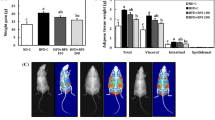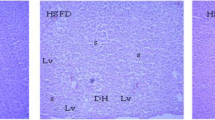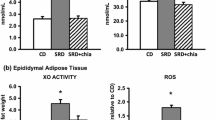Abstract
Obesity and associated diseases are world-wide problems. The preventive effect of purple sweet potato color (PSPC) on high fat diet (HFD) induced obesity was investigated along with the mechanism underlying the effect. Eight-week-old male Sprague Dawley strain rats were grouped into 7 groups and intragastrically administered PSPC once a day. Obesity was prevented and abnormal glucose, triglyceride, and total cholesterol levels induced by the HFD for 6 weeks were restored to near-normal levels. PSPC significantly (p<0.05) reduced the level of reactive oxygen species and inhibited the receptor of advanced glycation end products and thioredoxin interacting protein in the hypothalamus, compared with controls. PSPC preserved the leptin signaling capability, leading to a decrease in hypothalamic adenosine 5′-monophosphate activated protein kinase activity. The anti-obesity effects of PSPC were mediated via attenuation of oxidative stress and regulation of leptin/AMPK signaling in the hypothalamus.
Similar content being viewed by others
References
Suzuki R, Tanaka M, Takanashi M, Hussain A, Yuan B, Toyoda H, Kuroda M. Anthocyanidins-enriched bilberry extracts inhibit 3T3-L1 adipocyte differentiation via the insulin pathway. Nutr. Metab. 8: 14 (2011)
Lazar MA. How obesity causes diabetes: Not a tall tale. Science 307: 373–375 (2005)
Baumann H, Morella KK, White DW, Dembski M, Bailon PS, Kim H, Lai CF, Tartaglia LA. The full-length leptin receptor has signaling capabilities of interleukin 6-type cytokine receptors. P. Natl. Acad. Sci. USA 93: 8374–8378 (1996)
Ballinger A, Peikin SR. Orlistat: Its current status as an anti-obesity drug. Eur. J. Pharmacol. 440: 109–117 (2002)
Karamadoukis L, Shivashankar GH, Ludeman L, Williams AJ. An unusual complication of treatment with orlistat. Clin. Nephrol. 71: 430–432 (2009)
Yun JW. Possible anti-obesity therapeutics from nature-A review. Phytochemistry 71: 1625–1641 (2010)
Moriyama T, Kishimoto K, Nagai K, Urade R, Ogawa T, Utsumi S, Maruyama N, Maebuchi M. Soybean beta-conglycinin diet suppresses serum triglyceride levels in normal and genetically obese mice by induction of beta-oxidation, downregulation of fatty acid synthase, and inhibition of triglyceride absorption. Biosci. Biotech. Bioch. 68: 352–359 (2004)
Hwang JT, Park IJ, Shin JI, Lee YK, Lee SK, Baik HW, Ha J, Park OJ. Genistein, EGCG, and capsaicin inhibit adipocyte differentiation process via activating AMP-activated protein kinase. Biochem. Bioph. Res. Co. 338: 694–699 (2005)
Friedman JM, Halaas JL. Leptin and the regulation of body weight in mammals. Nature 395: 763–770 (1998)
Friedman JM. The function of leptin in nutrition, weight, and physiology. Nutr. Rev. 60: S1–S14 (2002)
Hardie DG, Scott JW, Pan DA, Hudson ER. Management of cellular energy by the AMP-activated protein kinase system. FEBS Lett. 546: 113–120 (2003)
Minokoshi Y, Alquier T, Furukawa N, Kim YB, Lee A, Xue B, Mu J, Foufelle F, Ferré P, Birnbaum MJ, Stuck BJ, Kahn BB. AMPkinase regulates food intake by responding to hormonal and nutrient signals in the hypothalamus. Nature 428: 569–574 (2004)
Dagon Y, Hur E, Zheng B, Wellenstein K, Cantley LC, Kahn BB. p70S6 kinase phosphorylates AMPK on serine 491 to mediate leptin's effect on food intake. Cell Metab. 16: 104–112 (2012)
Suda I, Oki T, Masuda M, Nishiba Y, Furuta S, Matsugano K, Sugita K, Terahara N. Direct absorption of acylated anthocyanin in purple-fleshed sweet potato into rats. J. Agr. Food Chem. 50: 1672–1676 (2002)
Zhang ZF, Lu J, Zheng YL, Wu DM, Hu B, Shan Q, Cheng W, Li MQ, Sun YY. Purple sweet potato color attenuates hepatic insulin resistance via blocking oxidative stress and endoplasmic reticulum stress in high-fat-diet-treated mice. J. Nutr. Biochem. 24: 1008–1018 (2013)
Shan Q, Zheng YL, Lu J, Zhang ZF, Wu DM, Fan SH, Hu B, Cai XJ, Cai H, Liu PL, Liu F. Purple sweet potato color ameliorates kidney damage via inhibiting oxidative stress mediated NLRP3 inflammasome activation in high fat diet mice. Food Chem. Toxicol. 69: 339–346 (2014)
Hosseinian FS, Li WD, Beta T. Measurement of anthocyanins and other phytochemicals in purple wheat. Food Chem. 109: 916–924 (2008)
Lu J, Wu DM, Zheng ZH, Zheng YL, Hu B, Zhang ZF. Troxerutin protects against high cholesterol-induced cognitive deficits in mice. Brain 134: 783–797 (2011)
Kim HW, Kim JB, Cho SM, Chung MN, Lee YM, Chu SM, Che JH, Kim SN, Kim SY, Cho YS, Kim JH, Park HJ, Lee DJ. Anthocyanin changes in the Korean purple-fleshed sweet potato, Shinzami, as affected by steaming and baking. Food Chem. 130: 966–972 (2012)
Chu HF, Pan MH, Ho CT, Tseng YH, Wang WW, Chau CF. Variations in the efficacy of resistant maltodextrin on body fat reduction in rats fed different high-fat models. J. Agr. Food Chem. 62: 192–197 (2014)
Arner P, Spalding KL. Fat cell turnover in humans. Biochem. Bioph. Res. Co. 396: 101–104 (2010)
Youdim KA, Shukitt-Hale B, Joseph JA. Flavonoids and the brain: Interactions at the blood–brain barrier and their physiological effects on the central nervous system. Free Radical Bio. Med. 37: 1683–1693 (2004)
Milbury PE, Kalt W. Xenobiotic metabolism and berry flavonoid transport across the blood-brain barrier. J. Agr. Food Chem. 58: 3950–3956 (2010)
Chutkow WA, Birkenfeld AL, Brown JD, Lee HY, Frederick DW, Yoshioka J, Patwari P, Kursawe R, Cushman SW, Plutzky J, Shulman GI, Samuel VT, Lee RT. Deletion of the alpha-arrestin protein Txnip in mice promotes adiposity and adipogenesis while preserving insulin sensitivity. Diabetes 59: 1424–1434 (2010)
Li X, Xiao Y, Gao H, Li B, Xu L, Cheng M, Jiang B, Ma Y. Grape seed proanthocyanidins ameliorate diabetic nephropathy via modulation of levels of AGE, RAGE, and CTGF. Nephron Exp. Nephrol. 111: e31–e41 (2009)
Halaas JL, Gajiwala KS, Maffei M, Cohen SL, Chait BT, Rabinowitz D, Lallone RL, Burley SK, Friedman JM. Weightreducing effects of the plasma protein encoded by the obese gene. Science 269: 543–546 (1995)
Campfield LA, Smith FJ, Guisez Y, Devos R, Burn P. Recombinant mouse OB protein: evidence for a peripheral signal linking adiposity and central neural networks. Science 269: 546–549 (1995)
Pelleymounter MA, Cullen MJ, Baker MB, Hecht R, Winters D, Boone T, Collins F. Effects of the obese gene product on body weight regulation in ob/ob mice. Science 269: 540–543 (1995)
Bjorbaek C, Uotani S, da Silva B, Flier JS. Divergent signaling capacities of the long and short isoforms of the leptin receptor. J. Biol. Chem. 272: 32686–32695 (1997)
Hill JW, Williams KW, Ye C, Luo J, Balthasar N, Coppari R, Cowley MA, Cantley LC, Lowell BB, Elmquist JK. Acute effects of leptin require PI3K signaling in hypothalamic proopiomelanocortin neurons in mice. J. Clin. Invest. 118: 1796–1805 (2008)
Zoncu R, Efeyan A, Sabatini DM. mTOR: From growth signal integration to cancer, diabetes and ageing. Nat. Rev. Mol. Cell Bio. 12: 21–35 (2011)
Carling D. The AMP-activated protein kinase cascade-a unifying system for energy control. Trends Biochem. Sci. 29: 18–24 (2004)
Hawley SA, Davison M, Woods A, Davies SP, Beri RK, Carling D, Hardie DG. Characterization of the AMP-activated protein kinase from rat liver and identification of threonine172 as the major site at which it phosphorylates AMP-activated protein kinase. J. Biol. Chem. 271: 27879–27887 (1996)
Jin HO, Seo SK, Kim YS, Woo SH, Lee KH, Yi JY, Lee SJ, Choe TB, Lee JH, An S, Hong SI, Park IC. TXNIP potentiates Redd1-induced mTOR suppression through stabilization of Redd1. Oncogene 30: 3792–3801 (2011)
Author information
Authors and Affiliations
Corresponding author
Rights and permissions
About this article
Cite this article
Zhang, Y., Niu, F., Sun, J. et al. Purple sweet potato (Ipomoea batatas L.) color alleviates high-fat-diet-induced obesity in SD rat by mediating leptin’s effect and attenuating oxidative stress. Food Sci Biotechnol 24, 1523–1532 (2015). https://doi.org/10.1007/s10068-015-0196-7
Received:
Revised:
Accepted:
Published:
Issue Date:
DOI: https://doi.org/10.1007/s10068-015-0196-7




